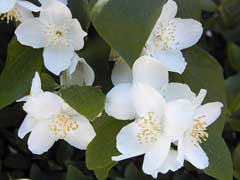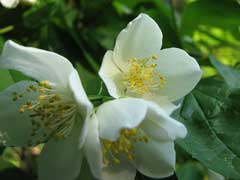 |
|
http://commons.wikimedia.org/wiki/User:Cillas |
 |
| www.flickr.com/photos/meanandpinchy |
Translate this page:
Summary
Physical Characteristics

 Philadelphus pubescens is a deciduous Shrub growing to 5 m (16ft) by 6 m (19ft).
Philadelphus pubescens is a deciduous Shrub growing to 5 m (16ft) by 6 m (19ft).
See above for USDA hardiness. It is hardy to UK zone 6. It is in flower from June to July. The species is hermaphrodite (has both male and female organs) and is pollinated by Insects.
Suitable for: light (sandy), medium (loamy) and heavy (clay) soils and can grow in heavy clay and nutritionally poor soils. Suitable pH: mildly acid, neutral and basic (mildly alkaline) soils and can grow in very alkaline soils.
It can grow in semi-shade (light woodland) or no shade. It prefers moist soil.
UK Hardiness Map
US Hardiness Map
Synonyms
Plant Habitats
Woodland Garden Sunny Edge; Dappled Shade; Hedge;
Edible Uses
References More on Edible Uses
Medicinal Uses
Plants For A Future can not take any responsibility for any adverse effects from the use of plants. Always seek advice from a professional before using a plant medicinally.
None known
References More on Medicinal Uses
The Bookshop: Edible Plant Books
Our Latest books on Perennial Plants For Food Forests and Permaculture Gardens in paperback or digital formats.

Edible Tropical Plants
Food Forest Plants for Hotter Conditions: 250+ Plants For Tropical Food Forests & Permaculture Gardens.
More

Edible Temperate Plants
Plants for Your Food Forest: 500 Plants for Temperate Food Forests & Permaculture Gardens.
More

More Books
PFAF have eight books available in paperback and digital formats. Browse the shop for more information.
Shop Now
Other Uses
Hedge Hedge Soap
The leaves are rich in saponins[169], when crushed and mixed with water they produce a lather that is an effective cleaner, used on the body, clothes etc. You can wash your hands by merely picking a couple of leaves or a bunch of blossom, wetting your hands and then rubbing the plant material vigorously as if it was a bar of soap[K]. This soap is a very gentle cleaner that does not remove the body's natural oils, but does remove dirt. It is not very effective against oil[K]. Plants can be grown as an informal hedge or screen[200].
Special Uses
Hedge Hedge Scented Plants
References More on Other Uses
Cultivation details
Easily grown in any moderately fertile soil, succeeding in thin soils over chalk[200]. Grows well in heavy clay soils. Tolerates poor soils[200]. Succeeds in semi-shade but prefers a position in full sun where it will flower more freely[182, 200]. Grows well on the woodland edge or in a glade[200]. Hardy to about -15°c[200]. The flowers are richly scented[245]. Plants are very tolerant of pruning, one third of the stems can be cut down to the ground each year in order to promote fresh growth and heavier flowering[202].
References Carbon Farming Information and Carbon Sequestration Information
Temperature Converter
Type a value in the Celsius field to convert the value to Fahrenheit:
Fahrenheit:
The PFAF Bookshop
Plants For A Future have a number of books available in paperback and digital form. Book titles include Edible Plants, Edible Perennials, Edible Trees,Edible Shrubs, Woodland Gardening, and Temperate Food Forest Plants. Our new book is Food Forest Plants For Hotter Conditions (Tropical and Sub-Tropical).
Shop Now
Plant Propagation
Seed - best if given 1 months cold stratification[113]. Sow February in a light position in a cold frame. When they are large enough to handle, prick the seedlings out into individual pots and grow them on in the greenhouse for their first winter. Plant them out into their permanent positions in late spring or early summer, after the last expected frosts. Cuttings of half-ripe wood, 7 - 10cm long side-shoots, July/August in a shaded frame. Plant out in spring. High percentage[78]. Cuttings of mature wood of the current year's growth, 15 - 25cm with a heel, December in a sheltered bed outdoors. Fair to good percentage[78]. Layering in summer. Very easy.
Other Names
If available other names are mentioned here
Native Range
NORTHERN AMERICA: United States (Connecticut, Massachusetts, Michigan, New York, Ohio, Iowa, Kansas, Illinois, Oklahoma, Oklahoma, Montana, Wyoming, Alabama, Arkansas, Georgia, Kentucky, Louisiana, Maryland, Mississippi, Tennessee, Virginia, Texas)
Weed Potential
Right plant wrong place. We are currently updating this section.
Please note that a plant may be invasive in one area but may not in your area so it's worth checking.
Conservation Status
IUCN Red List of Threatened Plants Status :

Growth: S = slow M = medium F = fast. Soil: L = light (sandy) M = medium H = heavy (clay). pH: A = acid N = neutral B = basic (alkaline). Shade: F = full shade S = semi-shade N = no shade. Moisture: D = dry M = Moist We = wet Wa = water.
Now available:
Food Forest Plants for Mediterranean Conditions
350+ Perennial Plants For Mediterranean and Drier Food Forests and Permaculture Gardens.
[Paperback and eBook]
This is the third in Plants For A Future's series of plant guides for food forests tailored to
specific climate zones. Following volumes on temperate and tropical ecosystems, this book focuses
on species suited to Mediterranean conditions—regions with hot, dry summers and cool, wet winters,
often facing the added challenge of climate change.
Read More
Expert comment
Author
Loisel.
Botanical References
11200274
Links / References
For a list of references used on this page please go here
Readers comment
| Add a comment |
|
If you have important information about this plant that may help other users please add a comment or link below. Only comments or links that are felt to be directly relevant to a plant will be included. If you think a comment/link or information contained on this page is inaccurate or misleading we would welcome your feedback at [email protected]. If you have questions about a plant please use the Forum on this website as we do not have the resources to answer questions ourselves.
* Please note: the comments by website users are not necessarily those held by PFAF and may give misleading or inaccurate information.
To leave a comment please Register or login here All comments need to be approved so will not appear immediately.
|
Subject : Philadelphus pubescens
|
|
|
|